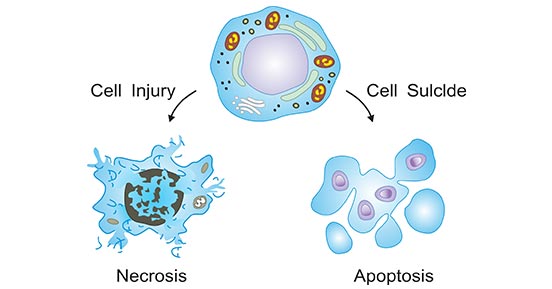What is the process that results in cellular death?
Atrophy.
Proliferation.
Mutation.
Death.
The Correct Answer is D
Choice A: Atrophy
Atrophy refers to the reduction in size or wasting away of an organ or tissue due to a decrease in cell size or number. This can occur due to various reasons such as disuse, lack of nutrition, or loss of nerve supply. While atrophy involves the shrinkage of cells, it does not directly result in cellular death. Instead, it is a form of cellular adaptation to adverse conditions.
Choice B: Proliferation
Proliferation is the process by which cells grow and divide to produce more cells. This process is essential for growth, development, and tissue repair. Proliferation leads to an increase in the number of cells and is the opposite of cellular death. It is a tightly regulated process that ensures the maintenance and regeneration of tissues.
Choice C: Mutation
Mutation refers to changes in the DNA sequence of a cell. These changes can occur due to errors during DNA replication, exposure to radiation, or chemical mutagens. While mutations can lead to various outcomes, including cancer, they do not directly cause cellular death. Instead, mutations can alter the function of genes and proteins, potentially leading to uncontrolled cell growth or other cellular dysfunctions.
Choice D: Death
Apoptosis is a form of programmed cell death that occurs in multicellular organisms. It is a highly regulated process that allows the body to remove damaged or unnecessary cells without causing harm to surrounding tissues. Apoptosis involves a series of biochemical events leading to characteristic cell changes and eventual death. This process is crucial for maintaining cellular homeostasis and preventing the development of diseases such as cancer.

Nursing Test Bank
Naxlex Comprehensive Predictor Exams
Related Questions
Correct Answer is C
Explanation
Choice A: Alkalosis
Alkalosis refers to a condition where the blood pH is higher than the normal range (above 7.45). In this case, the pH is 7.25, which indicates an acidic environment rather than an alkaline one. Therefore, alkalosis is not the correct answer.
Choice B: Respiratory
Respiratory acidosis or alkalosis is determined by the levels of PaCO2. In respiratory acidosis, PaCO2 is elevated, while in respiratory alkalosis, PaCO2 is decreased. Here, the PaCO2 is 20 mm Hg, which is below the normal range, indicating a respiratory component. However, the primary issue is not respiratory because the HCO3- is also significantly low, pointing towards a metabolic cause.
Choice C: Metabolic
Metabolic acidosis is characterized by a low pH and a low HCO3- level. In this case, the pH is 7.25, and the HCO3- is 10 mEq/L, both of which are below the normal ranges. This indicates that the primary acid-base imbalance is metabolic acidosis.
Choice D: Acidosis
Acidosis refers to a condition where the blood pH is lower than the normal range (below 7.35). The given pH of 7.25 confirms that the patient is experiencing acidosis. However, this choice alone does not specify whether it is metabolic or respiratory acidosis.
Choice E: With Compensation (Being Compensated)
Compensation refers to the body’s attempt to return the pH to normal by adjusting the levels of PaCO2 or HCO3-. In this case, the low PaCO2 suggests that there is a respiratory compensation for the metabolic acidosis. However, the primary imbalance remains metabolic acidosis.
Correct Answer is C
Explanation
Choice A Reason:
Beta2 agonists, such as terbutaline, are commonly used to manage premature labor. These drugs work by stimulating beta2 adrenergic receptors in the smooth muscles of the uterus, leading to relaxation and suppression of contractions. Therefore, questioning the use of a beta2 agonist in this scenario would not be appropriate.
Choice B Reason:
Anticholinergic drugs are not typically used to manage premature labor. They work by blocking the action of acetylcholine in the nervous system, which can lead to various effects such as reduced secretions and relaxation of smooth muscles. However, they are not specifically indicated for stopping uterine contractions, so questioning their use in this context is less relevant.
Choice C Reason:
This is the correct answer. Beta2 antagonists, also known as beta-blockers, work by blocking beta2 adrenergic receptors, which can lead to increased uterine contractions. Using a beta2 antagonist in a patient experiencing premature labor would be counterproductive and could exacerbate the condition. Therefore, it is appropriate to question the use of beta2 antagonists in this scenario.
Choice D Reason:
Alpha1 agonists are not typically used in the management of premature labor. These drugs stimulate alpha1 adrenergic receptors, leading to vasoconstriction and increased blood pressure. They do not have a direct effect on uterine contractions, so questioning their use in this context is less relevant.
Whether you are a student looking to ace your exams or a practicing nurse seeking to enhance your expertise , our nursing education contents will empower you with the confidence and competence to make a difference in the lives of patients and become a respected leader in the healthcare field.
Visit Naxlex, invest in your future and unlock endless possibilities with our unparalleled nursing education contents today
Report Wrong Answer on the Current Question
Do you disagree with the answer? If yes, what is your expected answer? Explain.
Kindly be descriptive with the issue you are facing.
